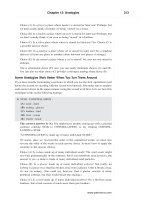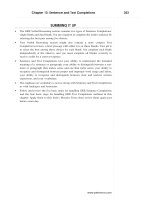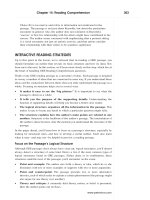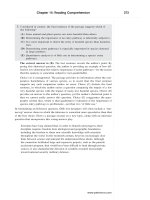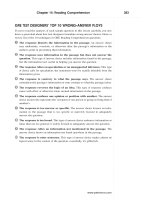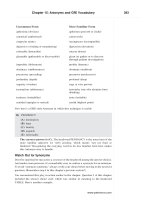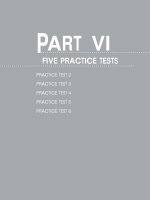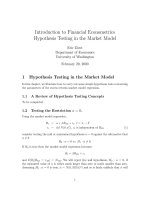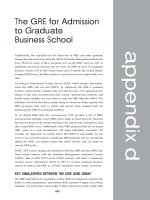Master the Market with Confidence_8 potx
Bạn đang xem bản rút gọn của tài liệu. Xem và tải ngay bản đầy đủ của tài liệu tại đây (149.37 KB, 8 trang )
example, here's how it works: If I get into a position and the market immediately goes against me
without giving me at least four tics first, I get stopped out of the trade for an 18-tic loss, but as I've
indicated, this doesn't happen often. More likely, the trade goes in my favor by some small amount
before becoming a loser. If it goes in my favor by at least four tics, I take those four tics on one
contract. What I have done is reduce my total risk on the other two contracts by 10 tics. If the market
then stops me out of the last two contracts, the net loss on the trade is only 8 tics. If I don't get stopped
out on the last two contracts and the market moves in my direction, I take the next third of the position
off at some predetermined profit objective.
This is based on some longer time frame support or resistance, or on the test of a previous significant
high or low. When I take profits on the second third, I also move the stop-loss to my original entry
point. Now I have a net profit on the trade regardless of what happens to the last third of the position.
In other words, I now have a "risk-free opportunity." I can't emphasize enough nor can the publisher
make the words on this page big enough to stress how important it is for you to experience the state of
"risk-free opportunity." When you set up a situation in which there is "risk-free opportunity," there's no
way to lose unless something extremely unusual happens, like a limit up or limit down move through
your stop. If, under normal circumstances, there's no way to lose, you get to experience what it really
feels like to be in a trade with a relaxed, carefree state of mind. To illustrate this point, imagine that you
are in a winning trade; the market made a fairly significant move in your direction, but you didn't take
any profits because you thought it was going even further.
However, instead of going further, the market trades all the way back to or very close to your original
entry point. You panic and, as a result, liquidate the trade, because you don't want to let what was once
a winning trade turn into a loser. But as soon as you're out, the market bounces right back into what
would have been a winning trade. If you had locked in some profits by scaling out, putting yourself in a
riskfree opportunity situation, it s very unlikely that you would have panicked or felt any stress or
anxiety for that matter. I still have a third of my position left. What now? I look for the most likely
place for the market to stop. This is usually a significant high or low in a longer time frame. I place my
order to liquidate just below that spot in a long position or just above that spot in a short position. I
place my orders just above or just below because I don't care about squeezing the last tic out of the
trade. I have found over the years that trying to do that just isn't worth it. One other factor you need to
take into consideration is your risk-to-reward ratio. The risk-to-reward ratio is the dollar value of how
much risk you have to take relative to the profit potential. Ideally, your risk-to-reward ratio should be at
least 3:1, which means you are only risking one dollar for every three dollars of profit potential. If your
edge and the way you scale out of your trades give you a 3:1 risk-to-reward ratio, your winning trade
percentage can be less than 50 percent and you will still make money consistently. A 3:1 risk-to-reward
ratio is ideal. However, for the purposes of this exercise, it doesn't matter what it is, nor does it matter
how effectively you scale out, as long as you do it. Do the best you can to pay yourself at reasonable
profit levels when the market makes the money available. Every portion of a trade that you take off as a
winner will contribute to your belief that you are a consistent winner. All the numbers will eventually
come into better alignment as your belief in your ability to be consistent becomes stronger.
Trading in Sample Sizes. The typical trader practically lives or dies (emotionally) on the results of the
most recent trade. If it was a winner, he'll gladly go to the next trade; if it wasn't, he'll start questioning
the viability of his edge. To find out what variables work, how well they work, and what doesn't work,
we need a systematic approach, one that doesn't take any random variables into consideration. This
means that we have to expand our definition of success or failure from the limited trade-by-trade
perspective of the typical trader to a sample size of 20 trades or more. Any edge you decide on will be
based on some limited number of market variables or relationships between those variables that
measure the market's potential to move either up or down. From the market's perspective, each trader
who has the potential to put on or take off a trade can act as a force on price movement and is,
therefore, a market variable. No edge or technical system can take into consideration every trader and
his reasons for putting on or taking off a trade. As a result, any set of market variables that defines an
edge is like a snapshot of something very fluid, capturing only a limited portion of all the possibilities.
When you apply any set of variables to the market, they may work very well over an extended period
of time, but after a while you may find that their effectiveness diminishes. That's because the
underlying dynamics of the interaction between all the participants (the market) is changing. New
traders come into the market with their own unique ideas of what is high and what is low, and other
traders leave.
Little by little, these changes affect the underlying dynamics of how the market moves. No snapshot
(rigid set of variables) can take these subtle changes into consideration. You can compensate for these
subtle changes in the underlying dynamics of market movement and still maintain a consistent
approach by trading in sample sizes. Your sample size has to be large enough to give your variables a
fair and adequate test, but at the same time small enough so that if their effectiveness diminishes, you
can detect it before you lose an inordinate amount of money. I have found that a sample size of at least
20 trades fulfills both of these requirements.
Testing. Once you decide on a set of variables that conform to these specifications, you need to test
them to see how well they work. If you have the appropriate software to do this, you are probably
already familiar with the procedures. If you don't have testing software, you can either forward test
your variables or hire a testing service to do it for you. If you need a recommendation for a testing
service, contact me at markdouglas.com or tradinginthezone.com for a referral. In any case, keep in
mind that the object of the exercise is to use trading as a vehicle to learn how to think objectively (in
the market's perspective), as if you were a casino operator. Right now, the bottom-line performance of
your system isn't very important, but it is important that you have a good idea of what you can expect
in the way of a win-to-loss ratio (the number of winning trades relative to the number of losing trades
for your sample size).
Accepting the Risk. A requirement of this exercise is that you know in advance exactly what your risk
is on each trade in your 20- trade sample size. As you now know, knowing the risk and accepting the
risk are two different things. I want you to be as comfortable as possible with the dollar value of the
risk you are taking in this exercise. Becuse the exercise requires that you use a 20-trade sample size, the
potential risk is that you will lose on all 20 trades. This is obviously the worst-case scenario. It is as
likely an occurrence as that you willwin on all 20 trades, which means it isn't very likely. Nevertheless,
it is a possibility. Therefore, you should set up the exercise in such a way that you can accept the risk
(in dollar value) of losing on all 20 trades.
For example, if you're trading S&P futures, your edge might require that you risk three full points per
contract to find out if the trade is going to work. Since the exercise requires that you trade a minimum
of three contracts per trade, the total dollar value of the risk per trade is $2,250, if you use big contracts.
The accumulated dollar value of risk if you lose on all 20 trades is $45,000, You may not be
comfortable risking $45,000 on this exercise.
If you're not comfortable, you can reduce the dollar value of the risk by trading S&P mini contracts (E-
Mini). They are one-fifth the value of the big contracts, so the total dollar value of the risk per trade
goes down to $450 and the accumulated risk for all 20 trades is $9,000. You can do the same thing if
you are trading stocks: Just keep on reducing the number of shares per trade until you get to a point
where you are comfortable with the total accumulated risk for all 20 trades. What I don't want you to
do is change your established risk parameters to satisfy your comfort levels.
If, based on your research, you have determined that a three-point risk in the S&Ps is the optimum
distance you must let the market trade against your edge to tell you it isn't worth staying in the position,
then leave it at three points. Change this variable only if it is warranted from a technical analysis
perspective. If you've done everything possible to reduce your position size and find that you still aren't
comfortable with the accumulated dollar value of losing on all 20 trades, then I suggest you do the
exercise with a simulated brokerage service. With a simulated brokerage service, everything about the
process of putting on and taking off trades, including fills and brokerage statements, is exactly the same
as with an actual brokerage firm, except that the trades are not actually entered into the market. As a
result, you don't actually have any money at risk. A simulated brokerage service is an excellent tool to
practice with in real time, under real market conditions; it is also an excellent tool for forward testing a
trading system. There may be others, but the only service of this nature that I know of is
Auditrack.com.
Doing the Exercise. When you have a set of variables that conforms to the specifications described,
you know exactly what each trade is going to cost to find out if it's going to work, you have a plan for
taking profits, and you know what you can expect as a win-loss ratio for your sample size, then you are
ready to begin the exercise. The rules are simple: Trade your system exactly as you have designed it.
This means you have to commit yourself to trading at least the next 20 occurrences of your edge—not
just the next trade or the next couple of trades, but all 20, no matter what. You cannot deviate, use or be
influenced by any other extraneous factors, or change the variables that define your edge until you have
completed a full sample size. By setting up the exercise with rigid variables that define your edge,
relatively fixed odds, and a commitment to take every trade in your sample size, you have created a
trading regime that duplicates how a casino operates.
Why do casinos make consistent money on an event that has a random outcome? Because they know
that over a series of events, the odds are in their favor. They also know that to realize the benefits of the
favorable odds, they have to participate in every event. They can't engage in a process of picking and
choosing which hand of blackjack, spin of the roulette wheel, or roll of the dice they are going to
participate in, by trying to predict in advance the outcome of each of these individual events. If you
believe in the five fundamental truths and you believe that trading is just a probability game, not much
different from pulling the handle of a slot machine, then you'll find that this exercise will be
effortless—effortless because your desire to follow through with your commitment to take every trade
in your sample size and your belief in the probabilistic nature of trading will be in complete harmony.
As a result, there will be no fear, resistance, or distracting thoughts. What could stop you from doing
exactly what you need to do, when you need to do it, without reservation or hesitation? Nothing!
On the other hand, if it hasn't already occurred to you, this exercise is going to create a head-on
collision between your desire to think objectively in probabilities and all the forces inside you that are
in conflict with this desire. The amount of difficulty you have in doing this exercise will be in direct
proportion to the degree to which these conflicts exist. To one degree or another, you will experience
the exact opposite of what I described in the previous paragraph. Don't be surprised if you find your
first couple of attempts at doing this exercise virtually impossible. How should you handle these
conflicts? Monitor yourself and use the technique of self-discipline to refocus on your objective. Write
down the five fundamental truths and the seven principles of consistency, and keep them in front of you
at all times when you are trading.
Repeat them to yourself frequently, with conviction. Every time you notice that you are thinking,
saying, or doing something that is inconsistent with these truths or principles, acknowledge the conflict.
Don't try to deny the existence of conflicting forces. They are simply parts of your psyche that are
(understandably) arguing for their versions of the truth. When this happens, refocus on exactly what
you are trying to accomplish. If your purpose is to think objectively, disrupt the association process (so
you can stay in the "now moment opportunity flow"); step through your fears of being wrong, losing
money, missing out, and leaving money on the table (so you can stop making errors and start trusting
yourself), then you'll know exactly what you need to do. Follow the rules of your trading regime as best
you can. Doing exactly what your rules call for while focused on the five fundamental truths will
eventually resolve all your conflicts about the true nature of trading. Every time you actually do
something that confirms one of the five fundamental truths, you will be drawing energy out of the
conflicting beliefs and adding energy to a belief in probabilities and in your ability to produce
consistent results. Eventually, your new beliefs will become so powerful that it will take no conscious
effort on your part to think and act in a way that is consistent with your objectives.
You will know for sure that thinking in probabilities is a functioning part of your identity when you
will be able to go through one sample size of at least 20 or more trades without any difficulty,
resistance, or conflicting thoughts distracting you from doing exactly what your mechanical system
calls for. Then, and only then, will you be ready to move into the more advanced subjective or intuitive
stages of trading.
A FINAL NOTE
Try not to prejudge how long it will take before you can get through at least one sample size of trades,
following your plan without deviation, distracting thoughts, or hesitation to act. It will take as long as it
takes. If you wanted to be a professional golfer, it wouldn't be unusual to dedicate yourself to hitting
10,000 or more golf balls until the precise combination of movements in your swing were so ingrained
in your muscle memory that you no longer had to think about it consciously. When you're out there
hitting those golf balls, you aren't playing an actual game against someone or winning the big
tournament. You do it because you believe that skill acquisition and practice will help you win.
Learning to be a consistent winner as a trader isn't any different. I wish you great prosperity, and would
say "good luck," but you really won't need luck if you work at acquiring the appropriate skills.
ATTITUDE SURVEY
1. To make money as a trader you have to know what the market is going co do next.
Agree Disagree
2. Sometimes I find myself thinking that there must be a way to trade without having to take a loss.
Agree Disagree
3. Making money as a trader is primarily a function of analysis.
Agree Disagree
4. Losses are an unavoidable component of trading.
Agree Disagree
5. My risk is always defined before I enter a trade.
Agree Disagree
6. In my mind there is always a cost associated with finding out what the market may do next.
Agree Disagree
7. I wouldn't even bother putting on the next trade if I wasn't sure that it was going to be a winner.
Agree Disagree
8. The more a trader learns about the markets and how they behave, the easier it will be for him to
execute his trades.
Agree Disagree
9. My methodology tells me exactly under what market conditions to either enter or exit a trade.
Agree Disagree
10. Even when I have a clear signal to reverse my position, I find it extremely difficult to do.
Agree Disagree
11. I have sustained periods of consistent success usually followed by some fairly drastic draw-downs
in my equity.
Agree Disagree
12. When I first started trading I would describe my trading methodology as haphazard, meaning some
success in between a lot of pain.
Agree Disagree
13. I often find myself feeling that the markets are against me personally.
Agree Disagree
14. As much as I might try to "let go," I find it very difficult to put past emotional wounds behind me.
Agree Disagree
15. I have a money management philosophy that is founded in the principle of always taking some
money out of the market when the market makes it available.
Agree Disagree
16. A trader s job is to identify patterns in the markets' behavior that represent an opportunity and then
to determine the risk of finding out if these patterns will play themselves out as they have in the past.
Agree Disagree
17. Sometimes I just can't help feeling that I am a victim of the market.
Agree Disagree
18. When I trade I usually try to stay focused in one time frame. Agree Disagree
19. Trading successfully requires a degree of mental flexibility far beyond the scope of most people.
Agree Disagree
20. There are times when I can definitely feel the flow of the market; however, I often have difficulty
acting on these feelings.
Agree Disagree
21. There are many times when I am in a profitable trade and I know the move is basically over, but I
still won't take my profits.
Agree Disagree
22. No matter how much money I make in a trade, I am rarely ever satisfied and feel that I could have
made more.
Agree Disagree
23. When I put on a trade, I feel I have a positive attitude. I anticipate all of the money I could make
from the trade in a positive way.
Agree Disagree
24. The most important component in a trader's ability to accumulate money over time is having a
belief in his own consistency.
Agree Disagree
25. If you were granted a wish to be able to instantaneously acquire one trading skill, what skill would
you choose?
26. I often spend sleepless nights worrying about the market.
Agree Disagree
27. Do you ever feel compelled to make a trade because you are afraid that you might miss out?
Yes No
28. Although it doesn't happen very often, I really like my trades to be perfect. When I make a perfect
call it feels so good that it makes up for all of the times that I don't.
Agree Disagree
29. Do you ever find yourself planning trades you never execute, and executing trades you never
planned?
Yes No
30. In a few sentences explain why most traders either don't make money or aren't able to keep what
they make.
